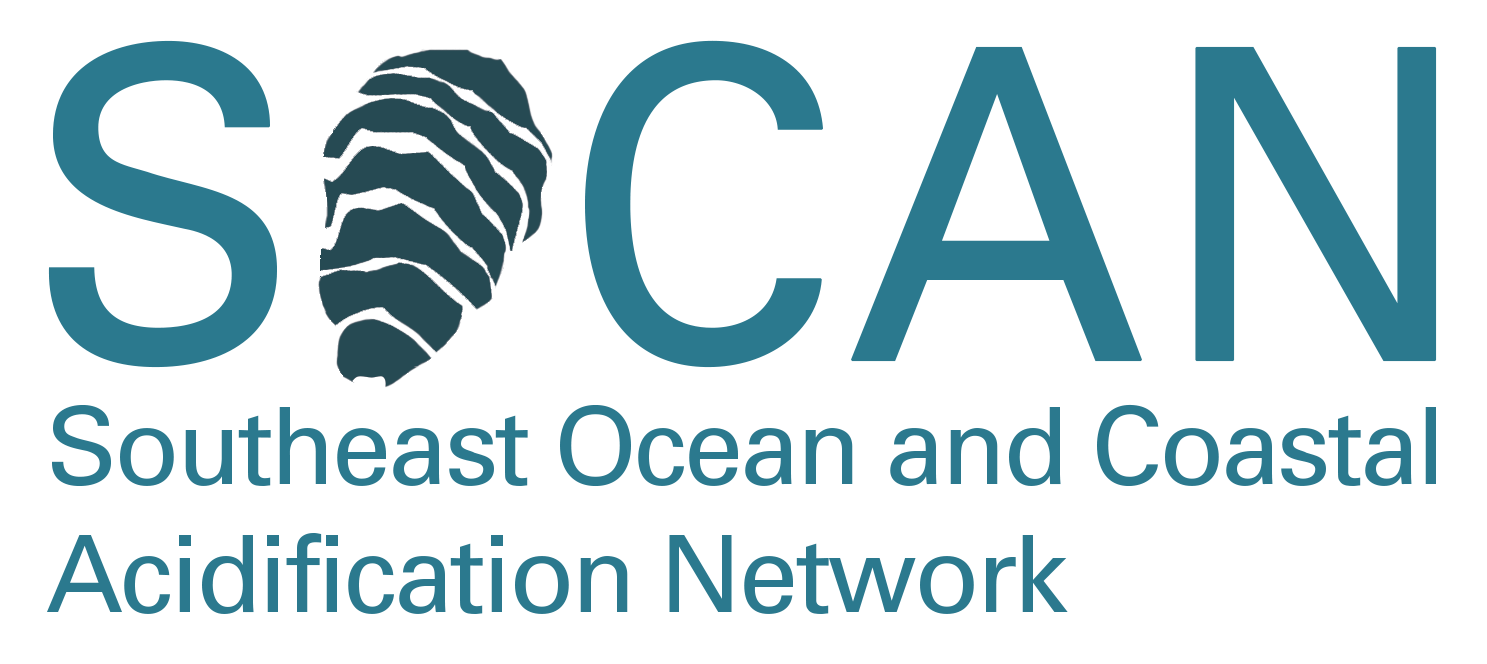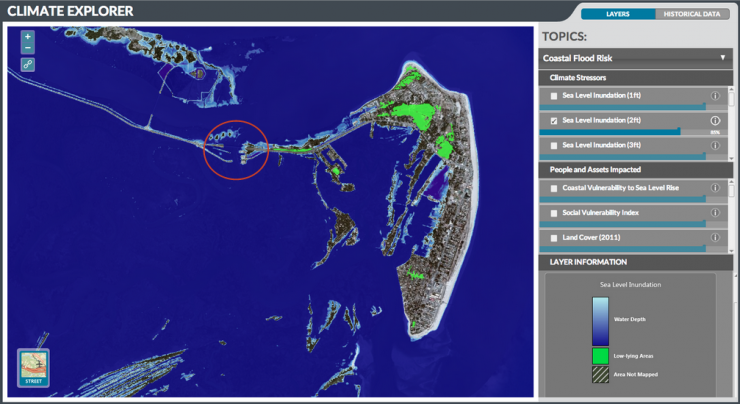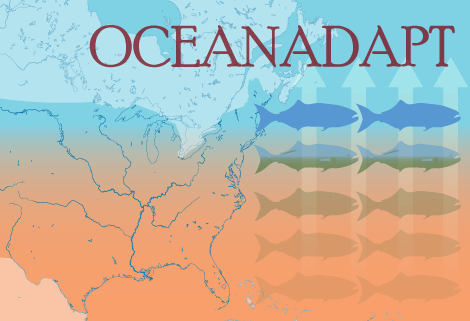|
Ocean Observing and Modeling Group
News and Updates
Vol. 2 Issue 1, Spring 2015
|
|
|
|
Greetings from OOMG!
In addition to the news items below, please visit our website for more information on our real-time model portal and data and analysis products.

|
|
OOMG News
)
Dr. Nancy White, director of the UNC Coastal Studies institute (CSI), visited the OOMG group on January 16. CSI is leading a renewable ocean energy research program that focuses on the potential of waves, tides, and currents to generate energy. Dr. He has participated in the renewable ocean energy program for several years, most recently by developing an integrated modeling-observing prediction and assessment system (more).
We welcomed Dr. Zhiren (Joseph) Wang as the newest postdoc research associate in early January. Dr. Wang, who received his PhD from Rutgers University in 2013, is working on modeling blooms of the red-tide causing alga Alexandrium fundyense in the Gulf of Maine. Also joining OOMG in January is Dr. Chuanjun Du, a visiting scholar from Xiamen University in Fujian, China. Dr. Du will be with us for five months, while he compares the marine biogeochemistry of the South China Sea to that of the Gulf of Mexico and Caribbean Sea.
Congratulations to Xiangming Zeng, who successfully passed his preliminary exams on April 9th, and became a PhD candidate.
Dr. Kerry Emanuel (middle of the photo), the Cecil and Ida Green Professor of Atmospheric Science at the Massachusetts Institute of Technology, visited OOMG on April 17. He was the invited speaker of "The Nature of Science: A Town Hall by Greg Fishel" program at the NC Museum of Natural Sciences, and gave a presentation on North Carolina Hurricanes: Past, Present and Future on April 16. Visiting NCSU's Department of MEAS on the 17th, he also gave a departmental seminar on Radiative-Convective Equilibrium and Its Instability: Implications for Weather and Climate.
|
|
New Publications by OOMG members
Li, Y., R. He, K. Chen, and D. McGillicuddy (2015) Variational data assimilative modeling investigation of Gulf of Maine coastal circulation in spring and summer 2010, Journal of Geophysical Research, in press.
Mann, D., C. Wall, C. Lambke, M. Lindemuth, R. He, C. Taylor, and T. Kellison (2014) Shelf-scale mapping of fish sound production with ocean gliders, Journal of the Acoustical Society of America, 136:2117, doi:10.1121/1.4899624.
North, E., E. Adams, A. Thessen. Z. Schlag, R. He, S. Socolofsky, S. Masutani, and S. Peckham (2015) The influence of droplet size and biodegradation of the transport of subsurface oil droplets during the Deepwater Horizon spill: a model sensitivity study, Environmental Research Letters, doi:10.1088/1748-9326/10/2/024016.
Ren, W., H. Tian, B. Tao, J. Yang, S. Pan, W. Cai, S. E. Lohrenz, R. He, and C. S. Hopkins (2015) Increase in dissolved inorganic carbon flux from the Mississippi River to Gulf of Mexico due to climatic and anthropogenic changes over the 21st century, Journal of Geophysical Research - Biogeosciences, doi: 10.1002/2014JG002761.
Xue, Z., J. Zambon, Z. Yao, Y. Liu, and R. He (2015) An integrated ocean circulation, wave, atmosphere, and marine ecosystem prediction system for the South Atlantic Bight and Gulf of Mexico, Journal of Operational Oceanography, doi: 10.1080/1755876X.2015.1014667.
Zeng, X., Y. Li, and R. He (2015) Predictability of the Loop Current variation and eddy shedding process in the Gulf of Mexico using an artificial neural network approach, Journal Atmospheric and Oceanic Technology, doi: 10.1175/JTECH-D-14-00176.1.
|
|
Related News
New SOCAN Network Encourages Ocean Acidification Discussions
 The Southeast Coastal Ocean Observing Regional Association (SECOORA) and NOAA are facilitating the formation of the Southeast Ocean and Coastal Acidification Network (SOCAN). With a focus on the southeast U.S. coastal and ocean waters, SOCAN will improve communications and collaborations around the causes, monitoring, and consequences of acidification. SOCAN is currently hosting a series of state-of-the-science webinars. The schedule and archives can be found here. Read more about SOCAN's mission and resources; join the listserv. The Southeast Coastal Ocean Observing Regional Association (SECOORA) and NOAA are facilitating the formation of the Southeast Ocean and Coastal Acidification Network (SOCAN). With a focus on the southeast U.S. coastal and ocean waters, SOCAN will improve communications and collaborations around the causes, monitoring, and consequences of acidification. SOCAN is currently hosting a series of state-of-the-science webinars. The schedule and archives can be found here. Read more about SOCAN's mission and resources; join the listserv.
Coastal and Marine Geology Video and Photograph Portal
 USGS has made available a collection of their images collected over several decades from select sections of the U.S. coast. Video and photography are available of the coasts of California and Massachusetts, and aerial imagery of the coastline along portions of the Gulf and mid-Atlantic coasts. Additional images will be posted as they become available. USGS has made available a collection of their images collected over several decades from select sections of the U.S. coast. Video and photography are available of the coasts of California and Massachusetts, and aerial imagery of the coastline along portions of the Gulf and mid-Atlantic coasts. Additional images will be posted as they become available.
Visit the portal.
Climate Explorer: Visualizing Data in Maps & Graphs

Climate Explorer is a research application built to support the U.S. Climate Resilience Toolkit by offering interactive visualizations for exploring maps and data related to the toolkit's Taking Action case studies. Map layers in the tool represent geographic information from climate.data.gov. Graphs display 1981-2010 U.S. Climate Normals for temperature and precipitation, overlain with daily observations from the Global Historical Climatology Network-Daily database. Use the tool.
OceanAdapt Tool Tracks Species' Shifts

NOAA Fisheries and Rutgers University have developed an informational tool that provides data about the distribution of U.S. marine fish and invertebrate species involved in commercial and recreational fishing. OceanAdapt allows users to track shifts in species distribution over time, from data collected by NOAA Fisheries and others. The webtool shows the magnitude, direction, and rate of change in species' depth and latitude. Nearly 650 species are included in this resource for managers, fishers, scientists, and others. Read more.
The New Climate Economy Global Action Plan
The Global Commission on the Economy and Climate, advised by some of the world's leading economists, has devised a ten point Global Action Plan for governments and businesses to achieve growth in a low-carbon economy. The report describes how countries around the world can reduce the risks of climate change and achieve high-quality, resilient, and inclusive economic growth. The recommendations fall into two classes of policy action: the necessary conditions for better, low-carbon, climate-resilient investment and growth, and the potential for change which drives future growth and lower climate risk, specifically in urban, land use, and energy sectors.
Coastal Ocean Modeling Seminar and Conference
The Coastal Ocean Modeling Gordon Research Conference and Seminar will be held in June 2015 at the University of New England. The Gordon-Kenan Research Seminar, titled “Modeling the Physics and Circulation of Coastal and Estuarine Environments,” will be held on June 6-7. Immediately following, the Gordon Research Conference, titled "Modeling Coastal Marine Circulation and Physics and the Environmental Processes that They Influence," will be held on June 7-12 and will be chaired by John Wilkin, with Ruoying He as vice chair. Application for the meetings close May 9 and 10, respectively. Read more on the conference and the seminar.
|
|
Many thanks to our sponsors:
![[logos of sponsors: NSF, NASA, NOAA, DOI,ONR, DOE, USGS, BOEM, Gulf of Mexico Research Initiative, SECOORA, Sea Grant NC, and UNC Coastal Studies Institute] [logos of sponsors: NSF, NASA, NOAA, DOI,ONR, DOE, USGS, BOEM, Gulf of Mexico Research Initiative, SECOORA, Sea Grant NC, and UNC Coastal Studies Institute]](./vol2_issue1_Apr2015_files/png)
|
|
The Ocean Observing and Modeling Group
Dept. of Marine, Earth and Atmospheric Sciences
North Carolina State University
visit our web page
Contact us: OceanObservingAndModeling@ncsu.edu
|
|
|
|
|
|
|